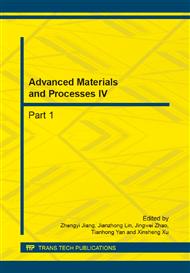p.491
p.495
p.499
p.504
p.509
p.513
p.517
p.521
p.526
Effect of Assets of Silicon Film Passivation Layer on the Performance of Silicon Nanowire Solar Cells
Abstract:
Silicon film as a surface passivation layer is reported to reduce surface recombination on silicon nanowires (SiNWs) and thus enable to improve SiNW solar cell (SC) performance. A question yet to be answered regards the link between the silicon film assets and the solar cell performances. We investigated the effect of the properties of silicon films on the SiNWs SC performances by adjusting hydrogen dilution. Our results showed that the open-circuit voltage (Voc) and short-circuit current density (Jsc) of SiNWs SC increase until hydrogen dilution 10 and then decrease. An open-circuit voltage of 0.397 V and short-circuit current density of 18.42 mA/cm2 are achieved at optimized hydrogen dilution. Based on the analysis of silicon film properties we proposed that the increase of defect density with hydrogen dilution was the main cause for the deterioration of SiNWs SC performance.
Info:
Periodical:
Pages:
509-512
Citation:
Online since:
September 2014
Authors:
Keywords:
Price:
Сopyright:
© 2014 Trans Tech Publications Ltd. All Rights Reserved
Share:
Citation:


